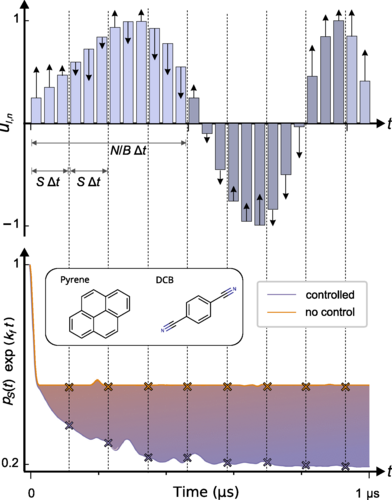Quantum control of radical pair dynamics, a rapidly evolving field within optimal quantum control (OQC), manipulates quantum scale phenomena using perturbations like electromagnetic pulses. It has seen significant success in nuclear magnetic resonance pulse engineering and ultrafast excited state reactions control. The field has applications in quantum information processing and quantum metrology, with a recent focus on spin-chemical reactions. The quantum control of radical pair dynamics could potentially be applied in quantum magnetometry and biochemical radical-pair reactions. It is also believed to underpin a compass sense in certain animals, including migratory songbirds.
What is Quantum Control of Radical Pair Dynamics?
Quantum control of radical pair dynamics is a rapidly evolving field within optimal quantum control (OQC). This discipline seeks to manipulate phenomena at the quantum scale by devising and implementing perturbations, typically in the form of electromagnetic pulses, to steer a given quantum system to a desired target. This field has seen significant successes in nuclear magnetic resonance (NMR) pulse engineering and the control of ultrafast excited state reactions by laser fields.
The field of OQC has matured into a central discipline in modern quantum technologies associated with the second quantum revolution. It has numerous applications across quantum information processing and quantum metrology. Recently, there has been a renewed focus on the quantum control of spin-chemical reactions, with the implementation of a gradient-ascent pulse engineering (GRAPE) inspired approach made computationally feasible via novel algorithmic modifications.
How Does Quantum Control of Radical Pair Dynamics Work?
Reactions involving the recombination of radical pair intermediates are known to depend on spin degrees of freedom and their intrinsic quantum dynamics. The electronic singlet and triplet states associated with the unpaired electrons for each radical can undergo coherent interconversion as a consequence of symmetry-breaking interactions, in particular, the hyperfine interactions with surrounding magnetic nuclei.
Quantum beats reflecting the coherent singlet-triplet interconversion in radical pairs have been directly revealed through pump-push spectroscopy. In the case of singlet and triplet states exhibiting differential chemical reactivity, the spin dynamics are reflected in the reaction yields realized via the singlet and triplet channels. By coupling to magnetic fields via the Zeeman interaction, radical pairs acquire sensitivity to static and oscillatory applied magnetic fields.
What are the Applications of Quantum Control of Radical Pair Dynamics?
The quantum control of radical pair dynamics has potential applications in quantum magnetometry and potentially in biochemical radical-pair reactions. The field has also been used to study the effects of oscillatory magnetic fields on radical-pair reactions, which play a discriminatory role in identifying magnetosensitive radical-pair reactions in spin-biological systems.
A majority of model studies on oscillatory magnetic field effects have applied monochromatic radiofrequency (rf) magnetic fields in the presence of a strong biasing field. Some studies have been realized in a weak static field, particularly for exciplex-forming systems. In such systems, the radical pair is in equilibrium with or can populate an exciplex state, making radical-pair dynamics accessible and measurable via the exciplex emission.
What is the Future of Quantum Control of Radical Pair Dynamics?
The future of quantum control of radical pair dynamics looks promising. The field is paving the way for reaction-yield-dependent quantum magnetometry and potentially applications of quantum control to biochemical radical-pair reactions. The field is also hypothesized to underpin a compass sense in various animals, including migratory songbirds, where the magnetosensitive radical pair is thought to originate from a photoinduced electron transfer reaction in the flavoprotein cryptochrome.
In conclusion, the quantum control of radical pair dynamics is a rapidly evolving field with numerous potential applications. The field is central to modern quantum technologies and has the potential to revolutionize our understanding of quantum dynamics and its applications in various fields.
Publication details: “Quantum Control of Radical-Pair Dynamics beyond Time-Local Optimization”
Publication Date: 2024-04-04
Authors: Farhan T. Chowdhury, Matt C.J. Denton, Daniel C. Bonser, Daniel R. Kattnig, et al.
Source: PRX Quantum 5, 020303
DOI: https://doi.org/10.1103/PRXQuantum.5.020303

